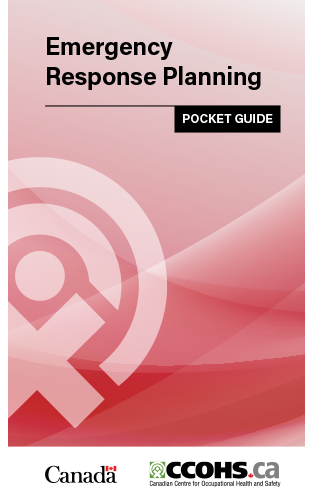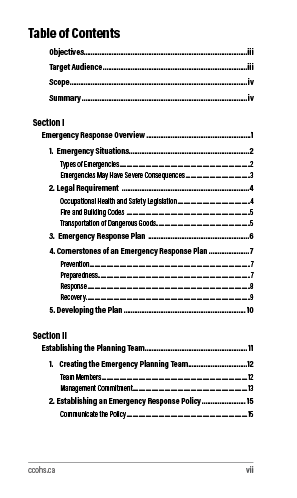Scheduled maintenance - Thursday, July 12 at 5:00 PM EDT
We expect this update to take about an hour. Access to this website will be unavailable during this time.
Develop an emergency response plan to prepare for crisis situations such as fires, chemical spills, bomb threats, floods, severe weather, injuries, illnesses, and climate-related emergencies.


Designed and written as a practical workplace reference, this 172-page pocket guide is filled with clear-language text including safety tips, illustrations, sample procedures and checklists.
Use this guide to develop a comprehensive emergency response plan. It will help you to:
This guide provides basic information to assist in the development of workplace emergency preparedness and response programs. All organizations should have an emergency response program in place. Customers and stakeholders expect it as an indication of reliable business operations. The content is organized around four key components of emergency preparedness: prevention, preparedness, response, and recovery. These components apply to a wide range of business sectors.
Guidelines for establishing a comprehensive emergency preparedness program depend on:
This guide is recommended for anyone who needs to implement an emergency response plan and manage comprehensive prevention programs within the organization.
It will also assist:
Each publication produced by CCOHS undergoes several stages of review. As part of this review, representatives from government, employers, and labour are requested to comment on draft copies of CCOHS documents for technical accuracy and readability.
Although every effort is made to ensure the accuracy and completeness of the information, it is understood that CCOHS makes no warranty as to the accuracy or completeness of such information and assumes no liability for any damages or loss suffered as a result of any inaccuracy or incompleteness therein.
Version: Second edition
Publication date: September, 2025
CCOHS publications are unique in that they are developed by subject specialists in the field, and reviewed by representatives from labour, employers and government to ensure the content and approach are unbiased and credible.
Although our publications are protected by copyright, permission for non-commercial reproduction may be provided.
Please use our Copyright Authorization Form to request permission, or contact us for more information.